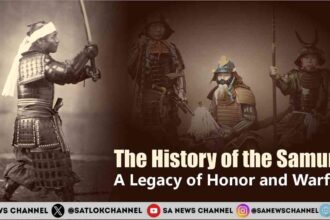The Vikings, originating from the rugged lands of Scandinavia, were a people marked by their fierce warrior spirit, seafaring prowess, and adventurous nature. Between the 8th and 11th centuries, they roamed across Europe and beyond, leaving an indelible mark on history through their raids, trade networks, and exploration.
- Scandinavian Roots: A Culture of Survival and Ambition
- A Stratified Yet Fluid Social Order Viking society was hierarchical but allowed for upward mobility
- Norse Beliefs and Their Influence
- The Viking Age Begins: Raids and Expansion
- From Pillaging to Establishing Power
- Colonization Across Continents
- Maritime Mastery: The Secret to Viking Success
- Longships: Engines of Conquest and Exploration
- Navigational Expertise
- Traders of the World: The Vikings’ Economic Networks
- A Diverse Array of Goods
- Exports: Amber, furs, iron, walrus ivory, and slaves.
- Imports: Silks, spices, silver, and luxury goods.
- The Varangian Guard
- Everyday Life: A Glimpse into Viking Society
- Legacy of the Vikings
- Linguistic and Cultural Contributions
- Advancements in Navigation and Shipbuilding
- Modern Fascination
- The Multifaceted Vikings
- A Legacy of Ambition and Resilience
- Decline of the Viking Age
- Christianization of Scandinavia
- Stronger European Defenses
- Economic and Climatic Changes
- The Enduring Allure of the Vikings
- Spiritual Perspective
- FAQs on The history of Vikings
- 1. Who were the Vikings?
- 2. What were Viking longships?
- 3. Did Vikings discover North America?
- 4. Were Vikings only raiders?
- 5. How did the Viking Age end?
- Connect With Us on the Following Social Media Platforms
From the shores of North America to the bustling markets of Constantinople, the Vikings were driven by a quest for wealth, adventure, and power. This article delves into the origins, societal structure, maritime innovations, and lasting legacy of the Vikings, painting a comprehensive picture of their complex and influential culture.
The Vikings, originating from the harsh landscapes of Scandinavia, emerged as one of the most dynamic and influential groups of the medieval world. Known for their fearsome raids and pioneering explorations, they profoundly shaped the cultural, political, and economic landscape of Europe and beyond. Active between 793 CE and 1066 CE, their era, known as the Viking Age, was a testament to their adaptability, maritime prowess, and ambition.
Scandinavian Roots: A Culture of Survival and Ambition
The Viking homeland encompassed modern-day Denmark, Norway, and Sweden. These regions were characterized by challenging climates, limited arable land, and rugged terrain. These environmental conditions demanded resilience and resourcefulness, shaping the Viking character and inspiring their eventual expansion across seas and continents.
A Stratified Yet Fluid Social Order Viking society was hierarchical but allowed for upward mobility
1. Jarls: Nobles and leaders, these individuals held wealth and commanded armies.
2. Karls: Free men and women who worked as farmers, artisans, and traders.
3. Thralls: Enslaved people who performed menial labor.
Despite the rigid hierarchy, opportunities for mobility existed, often achieved through valor in battle or success in trade.
Norse Beliefs and Their Influence
Norse refers to the culture, mythology, and practices of the Norsemen (Scandinavian people) during the Viking Age (roughly 793–1066 CE). Their belief system included a pantheon of gods like Odin, Thor, and Freyja, and a worldview centered around valor, nature, and the afterlife concepts such as Valhalla.
■ Also Read: From Samurai to Superpower: A Deep Dive into Japan’s Rich History and Cultural Evolution
Religion and mythology played a central role in Viking life. They worshipped gods like Odin, Thor, and Freyja, whose stories were passed down through oral traditions and later written in sagas. These beliefs encouraged courage, exploration, and a deep respect for nature, seen as imbued with divine forces. Their understanding of life after death, especially the promise of Valhalla for fallen warriors, motivated their bold and fearless endeavors.
The Viking Age Begins: Raids and Expansion
The Viking Age officially began in 793 CE with the attack on the Lindisfarne Monastery in England. This brutal raid shocked Europe, marking the arrival of a formidable force that would dominate the following centuries.
From Pillaging to Establishing Power
Early Viking activities were opportunistic raids targeting unprotected monasteries and settlements. Over time, they transitioned to more organized invasions aimed at territorial expansion. Significant milestones include:
- The Danelaw in England: Danish Vikings occupied large regions of England, leaving a lasting cultural and linguistic impact.
- Ireland: Viking settlements like Dublin became thriving trade and political centers.
- Normandy: The establishment of Normandy by Rollo in 911 CE showcased the Vikings’ adaptability, as they integrated into local cultures and governance structures.
Colonization Across Continents
While raids characterized the early Viking Age, later years saw them settling and colonizing distant lands, including:
- Iceland: Settled in 874 CE, it became a hub for Viking culture and literature.
- Greenland: Colonized by Erik the Red, it represented Viking resilience in hostile environments.
- North America: Leif Erikson’s journey to Vinland around 1000 CE made the Vikings the first Europeans to reach the Americas.
Maritime Mastery: The Secret to Viking Success
The Vikings’ success as explorers, traders, and raiders hinged on their extraordinary maritime capabilities.
Longships: Engines of Conquest and Exploration
Viking longships were revolutionary in their design. Their shallow drafts allowed them to navigate rivers and coastal waters, while their symmetrical construction enabled quick direction changes. These ships could travel vast distances, carrying both warriors and trade goods, making them indispensable to Viking endeavors.
Navigational Expertise
The Vikings relied on natural indicators such as the sun, stars, and ocean currents to navigate uncharted waters. They also used tools like the sunstone, which helped them determine direction even on overcast days. These skills allowed them to reach far-flung destinations, from the icy shores of Greenland to the bustling markets of Constantinople.
Traders of the World: The Vikings’ Economic Networks
The Vikings were more than raiders; they were skilled traders who connected Europe to distant regions. Their trade routes stretched from the Islamic Caliphates to the Byzantine Empire and beyond.
A Diverse Array of Goods
The Vikings traded in a variety of items:
Exports: Amber, furs, iron, walrus ivory, and slaves.
Imports: Silks, spices, silver, and luxury goods.
Their markets were bustling hubs of cultural exchange, where ideas, technologies, and traditions flowed freely between civilizations.
The Varangian Guard
Swedish Vikings, known as Varangians, established significant trade routes along rivers leading to the Byzantine Empire. Many served as elite guards for Byzantine emperors, cementing their reputation as formidable warriors and shrewd diplomats.
Everyday Life: A Glimpse into Viking Society
While their exploits abroad garnered fame, the Vikings’ domestic life was no less intriguing.
Farming and Sustenance
Agriculture formed the backbone of Viking society. They cultivated grains like barley and rye, raised livestock, and relied on fishing and hunting. Their diet was diverse, including bread, dairy products, and preserved meats, ensuring sustenance during long winters.
Gender Roles and Contributions
Women in Viking society enjoyed more rights and responsibilities than their counterparts in many other medieval cultures. They managed households, participated in trade, and could inherit property. Some women, known as shieldmaidens, even joined men in battle, reflecting the Vikings’ progressive views on gender roles.
Artistic and Cultural Achievements
Viking artisans were skilled in metalwork, wood carving, and textile production. Their intricate designs, often featuring interwoven patterns and animal motifs, adorned everything from jewelry to weapons. Storytelling also held a central place in their culture, with sagas preserving their myths, legends, and historical events.
Legacy of the Vikings
The Vikings left an indelible mark on history, influencing cultures, politics, and economies across continents.
Linguistic and Cultural Contributions
The Vikings’ influence is evident in languages, with Old Norse words like “sky,” “window,” and “berserk” entering English. Place names across the British Isles and Normandy also bear testimony to their presence.
Advancements in Navigation and Shipbuilding
Their innovations in maritime technology set the stage for later explorations during the Age of Discovery. Their longships remain iconic symbols of engineering excellence.
Modern Fascination
The Vikings continue to captivate modern audiences, inspiring books, films, and TV series. Their artifacts, preserved in museums, offer glimpses into their sophisticated society and enduring legacy.
The Multifaceted Vikings
The Vikings were far more than their popular image as raiders suggests. They were pioneers who reshaped the medieval world through exploration, trade, and cultural exchange.
A Legacy of Ambition and Resilience
Their ability to adapt to diverse environments, establish settlements, and navigate uncharted waters reflects their resilience and ingenuity. As warriors, traders, and settlers, they demonstrated a blend of ferocity and sophistication that few cultures can match.
Decline of the Viking Age
By the mid-11th century, the Viking Age was drawing to a close. Several factors contributed to this decline:
Christianization of Scandinavia
As Scandinavia embraced Christianity, traditional Viking practices, including raiding and pagan rituals, waned. Christian kings unified the region under centralized rule, discouraging the fragmented tribal warfare that had fueled Viking expeditions.
Stronger European Defenses
The consolidation of power in England, France, and other European regions led to improved defenses, making Viking raids less successful. Coastal fortifications and organized armies presented significant challenges to Viking forces.
Economic and Climatic Changes
Shifts in trade routes and a warming climate reduced the necessity for expansion. The Vikings began focusing on internal development rather than external conquests.
The Enduring Allure of the Vikings
Today, the Vikings symbolize human ambition and the spirit of exploration. Their stories, preserved in sagas and archaeological discoveries, continue to inspire awe and curiosity, ensuring that their legacy remains alive.
Spiritual Perspective
The Viking Spirit: A Journey Through Norse Beliefs and Spiritual Insights
The Vikings, known for their seafaring and warrior culture, were deeply influenced by their Norse beliefs and mythology, which shaped their worldview and actions. They revered gods like Odin, Thor, and Freyja, whose tales of strength, wisdom, and valor inspired their lifestyle. The concept of Valhalla, a warrior’s paradise for those who died bravely in battle, fueled their fearlessness in exploration and warfare.
These beliefs also fostered a profound connection with nature, viewed as sacred and filled with divine forces. However, from the perspective of spiritual wisdom emphasized by The Chyren Sant Rampal Ji Maharaj, such practices and beliefs stem from incomplete understanding. Scriptures like the Bhagavad Gita and Holy Bible highlight the futility of material pursuits and the need to seek true salvation through devotion to the Supreme God, Kabir Saheb.
While the Vikings sought honor and valor, their ultimate goal was not aligned with attaining eternal peace. Sant Rampal Ji teaches that true liberation lies not in myths or temporary heavens but in following the path of true worship as per scriptures like the Holy Gita (18:62), which guides souls to surrender to the Supreme Creator. Thus, the Vikings’ legacy, though remarkable, underscores the universal human quest for spiritual truth and salvation.
Spiritual Leader Sant Rampal Ji’s perspective emphasizes the importance of devotion to a single true God and adherence to His teachings as the path to salvation. According to Sant Rampal Ji, life’s purpose is to seek and worship God correctly, which involves understanding and practicing the true knowledge of the scriptures.
He believes that true spirituality is about inner peace and transformation, rather than rituals or external displays of piety. Sant Rampal Ji promotes a rational and scientific approach to spirituality, advocating for the practice of true dharma, living according to the commands of God as outlined in sacred texts like the Gita, Quran, and Bible.
His teachings stress the importance of renouncing false beliefs, rituals, and superstitions, and instead focus on meditation and simran (remembrance of God’s name) as the way to connect with the divine. Sant Rampal Ji’s vision is a path of simplicity, wisdom, and direct communication with God, aiming to bring true freedom from worldly desires and liberation from the cycle of birth and death.
FAQs on The history of Vikings
1. Who were the Vikings?
The Vikings were seafaring people from Scandinavia (modern-day Norway, Sweden, and Denmark) known for their raids, exploration, and trade during the Viking Age (793–1066 CE).
2. What were Viking longships?
Viking longships were advanced vessels designed for speed, shallow-water navigation, and versatility, enabling their success in both raids and long-distance explorations.
3. Did Vikings discover North America?
Yes, around 1000 CE, Leif Erikson and his crew reached Vinland (modern-day Newfoundland), making the Vikings the first Europeans to set foot in North America.
4. Were Vikings only raiders?
No, Vikings were also skilled traders, farmers, and settlers. They established trade routes across Europe, Asia, and the Middle East.
5. How did the Viking Age end?
The Viking Age ended due to the Christianization of Scandinavia, stronger European defenses, and changing economic conditions by the mid-11th century.









